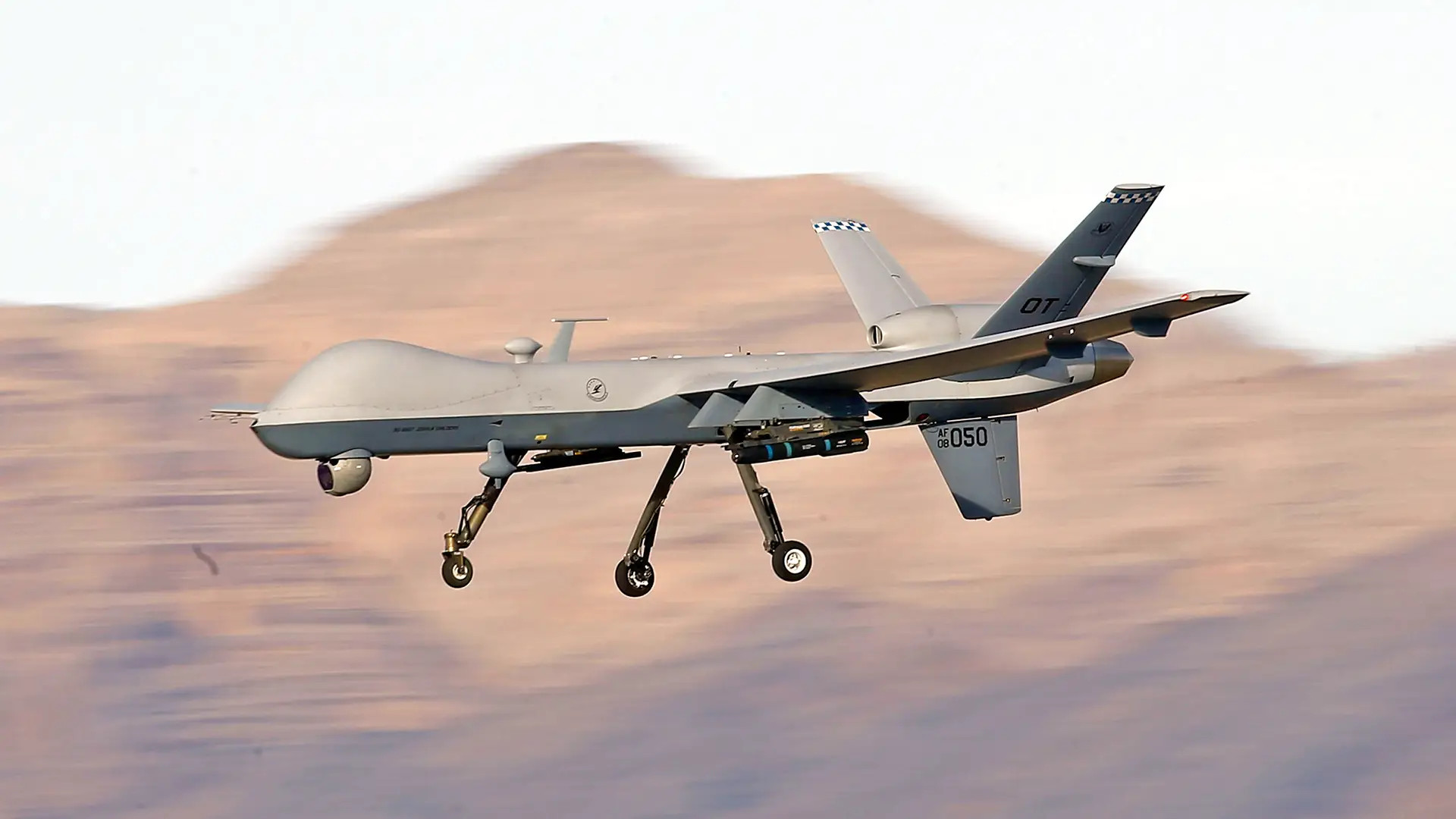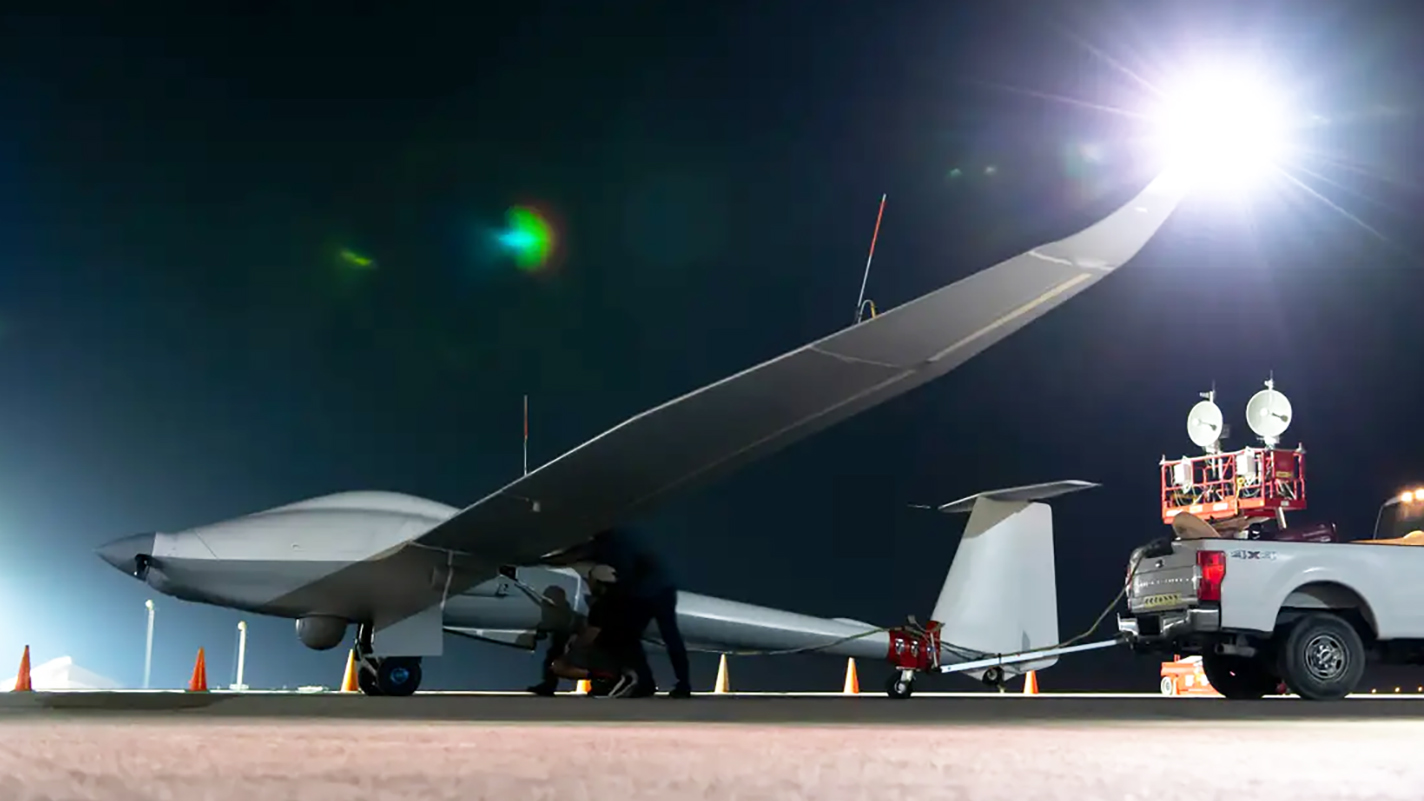The U.S. Air Force is now operating its Unmanned Long-endurance Tactical Reconnaissance Aircraft, or ULTRA, from Al Dhafra Air Base in the United Arab Emirates. The drone was developed as a low-cost, ultra-long-endurance, intelligence, surveillance, and reconnaissance (ISR) platform, one of a number of efforts that seek to plug critical gaps in the Air Force’s reconnaissance capabilities.

The Air Force has published a series of photos showing crew chiefs preparing an ULTRA drone for an early-morning mission on May 7 at what it describes as “an undisclosed location within Central Command area of responsibility.” That location can be identified as Al Dhafra — a key Air Force hub in the region, and home of the 380th Air Expeditionary Wing — thanks to the hangar in the background of some of the photos. This building was previously used to house RQ-4 Global Hawk ISR drones.
The sailplane-like ULTRA drone has notably long wings with winglets, a T-tail, and a retractable undercarriage. An electro-optical/infrared sensor turret is fitted below the fuselage, just ahead of the wing.
Few other details are provided by the Air Force in relation to these photos, although several are described as showing crew chiefs use a transponder interrogator to confirm the proper transponder function on the ULTRA drone.


Another photo shows an MQ-9 Reaper on the flight line in front of the ULTRA, with another two Reapers in an adjacent hangar.

Of the ULTRA, the Air Force says the drone provides “intelligence, surveillance, and reconnaissance capabilities to combatant commanders, with a smaller operational footprint than other UAS in its class.”
The origins of ULTRA lie in a program run by the Air Force Research Laboratory (AFRL) Center for Rapid Innovation (CRI), with the aircraft itself developed in conjunction with DZYNE Technologies Incorporated.
Specifications of the drone include an endurance of up to 80 hours while carrying a payload of more than 400 pounds. This compares to an operational endurance of around 27 hours for the MQ-9, according to figures from the manufacturer, although the latest Reaper derivatives can fly substantially longer when lightly loaded.

According to AFRL, ULTRA “provides combatant commanders with full global operational access in an inexpensive, GPS hardened, ultra-long endurance intelligence, surveillance and reconnaissance (ISR) platform.” AFRL further claims the drone is “truly unique in its ability to conquer the tyranny of distance that inhibit operational use of current unmanned platforms at excessive ranges required in areas of operations such as the Pacific.”
As an “ISR truck,” ULTRA is designed to carry various intelligence-collection payloads, with sensors chosen depending on the particular mission.
It is also worth considering that ULTRA could fill an important niche as an airborne datalink relay node, extending the range of communications on behalf of other assets, as well as providing a active data exchange network over a certain geographical area, all the way down to sea level.
Central to ULTRA’s utility is its long endurance, which means that a smaller number of drones are required to maintain overwatch of areas of interest. The fact that the drone’s payloads can be reconfigured further helps to drive down costs since the same aircraft can conduct different missions.

With the Pentagon increasingly focused on potential future conflicts in the Asia Pacific region, the requirement for persistent ISR has grown. Not only are the areas of interest that require surveillance coverage spread over a very wide area, but basing options are limited by geography and China’s ability to hold many traditional basing options at risk. Using traditional crewed and uncrewed ISR platforms in such scenarios may mean they only have a limited time on station — if they are able to reach the operational area in the first instance.
ULTRA has sought to meet these challenges by combining long endurance with low cost. In the past, AFRL has said that this will “enable the USAF to … economically procure aircraft systems in large quantities.”
Key to driving down the costs of the ULTRA program is the use of an unspecified “previously manned commercial sport glider,” according to AFRL. The drone also makes use of commercial-off-the-shelf (COTS) technology in its avionics, as well as its electro-optical/infrared and radio-frequency sensor payloads.
Since ULTRA is designed to operate at lower levels than high-altitude ISR drones, it doesn’t need the same kind of large optics and high-power radio-frequency sensors, which are also more expensive. Having said that, the exact altitudes that the drone operates at — and its other performance margins — are unclear.
Similarly, few, if any, details have been published about ULTRA’s payloads and avionics, but it’s known to use satellite-based command and control links that also transmit gathered intelligence in real-time.

How long ULTRA has been at Al Dhafra and what kinds of operations it is conducting from that base are also unknown. The Pentagon had dropped a potential hint about this deployment last year in a quarterly report on ongoing U.S. government activities related to Afghanistan released in March 2023.
“The Office of the Under Secretary of Defense for Policy (OUSD(P)) said that the DoD intends to eventually field a platform with longer loiter time to complement the MQ-9 Reapers currently in use, which can remain in the air for only a limited time after the lengthy transit into Afghanistan and conserving enough fuel for the return flight,” according to that Report. “OUSD(P) noted that Air Force Research Lab is planning to conduct such an assessment using an experimental platform in support of USCENTCOM requirements, possibly in the third quarter of FY 2023.”
When asked at the time for more information about this experimental platform and whether or not the assessment in question was related to potential ISR operations over Afghanistan, AFRL told TWZ that “we cannot elaborate due to operational security.”
The long-endurance capabilities that ULTRA offers could be valuable for ISR missions elsewhere across the region, including just in and around the Persian Gulf, as well. There is also the ongoing conflict in the Gaza Strip, which the U.S. military has sent drones to monitor at times, as well as the need for persistent surveillance to watch for Houthi missile and drone launches in Yemen. These are just some of the hotspots that could be with ULTRA’s range from Al Dhafra.
TWZ has reached out to CENTCOM for additional comment on the current ULTRA activities at Al Dhafra.
ULTRA also looks to have evolved, at least in part, from a highly secretive U.S. special operations drone program called the Long Endurance Aircraft Program (LEAP), which Dzyne has also been involved with. At least one of those drones was forward deployed in Erbil, the capital of Iraq’s semi-autonomous northern Kurdish region, until it crashed, in 2020. That accident helped reveal previously unknown details about LEAP, as TWZ was the first to report on the following year.
In May 2021, the U.S. Department of Defense confirmed that the secretive Joint Special Operations Command, or perhaps other U.S. government entities operating in cooperation with it, was flying a new type of drone in the Middle East. The Pentagon said this drone, developed under the Long Endurance Aircraft Program (LEAP), was designed to have a very low noise signature and an innocuous outward appearance.
This confirmation came in the form of an official accident report that The War Zone obtained via the Freedom of Information Act, detailing the loss of one of the LEAP drones at Erbil International Airport in Iraq, on July 24, 2020. Although heavily redacted, the report stated that the drone was derived from the Pipistrel Sinus, making it distinct from the sport glider-based ULTRA.

The Air Force said that the drone in question, valued at $3.4 million, was a complete write-off.
Soon after, a U.S. Special Operations Command (SOCOM) spokesperson told TWZ that the command was using a Sinus aircraft converted into a drone by the AFRL. “SOCOM has been assessing this platform as an option as we work with our military services and industry partners to identify low-cost, high-endurance airborne intelligence, surveillance, and reconnaissance solutions,” said U.S. Navy Commander Tim Hawkins. “This unmanned aerial system is contractor-operated and has a payload that includes a combination of full-motion video and signals intelligence sensors.”

Back in December 2019, the AFRL had announced that its Center for Rapid Innovation had completed a series of flight tests at Dugway Proving Ground in Utah in support of what was then referred to as the Ultra Long Endurance Aircraft Platform (Ultra LEAP) program. That testing ended with “a two-and-a-half-day continuous flight demonstration” of a “high-performance, cost-effective, sport-class commercial airframe converted to a fully automated system with autonomous takeoff and landing capabilities.”
At the time of the Dugway trials, AFRL said that “the system could be ready for operational fielding as soon as 2020.” It also released a rendering of the Ultra LEAP drone, seen below, that did not appear directly related to the LEAP aircraft and had a design much more in line with that of ULTRA.

In 2020, meanwhile, Pipistrel-USA, the Pipistrel subsidiary in the United States, disclosed more details of the AFRL’s work with its Sinus design on behalf of SOCOM.
“The Air Force Research Laboratory has demonstrated the suitability of Pipistrel light aircraft for SOCOM, installing sensors to collect full motion video, lidar [light detection and ranging], and signals intelligence with many units already deployed and operating around the globe,” the company said.

Pipistrel has also been marketing an uncrewed derivative of its Surveyor aircraft, which is also related to the Sinus design, for military use. The company claims that this drone can fly at altitudes up to 30,000 feet, remain aloft for up to 30 hours, and cover a total distance of up to nearly 2,800 miles, depending on payload, altitude, mission profile, and other factors.
The company confirmed in May 2020 that contractors had been operating Surveyor drones in support of SOCOM since 2013, suggesting a much longer U.S. military relationship with this and related platforms than had previously been understood.

Whatever ULTRA is currently being used for in the Middle East, it appears the U.S. military has gotten closer to its long-held ambition of fielding a lower-cost alternative to the MQ-9 for some long-endurance surveillance missions. The lower cost should also make these drones at least somewhat attritable — meaning they are inexpensive enough for combat commanders to be willing to lose them on high-risk missions.
The growing push toward developing long-endurance, lower-cost ISR assets is also evidenced by drones from Vanilla Unmanned, which can stay up for days at a time, as well as the high-altitude balloons from Raven Aerostar, configured as sensor platforms, but also eyed for a wide variety of other missions.
More broadly, the Pentagon and U.S. intelligence community have for decades been interested in the potential of highly efficient aircraft — whether crewed or uncrewed — that can loiter over a particular area for an extended period, while also offering a low acoustic signature and a platform that is less likely to arouse suspicion if spotted.
The ULTRA would certainly seem to meet these descriptions and we will continue to monitor this low-profile program that could be of great significance within the CENTCOM area of responsibility and many other theaters of operation beyond that.
Contact the author: thomas@thewarzone.com
